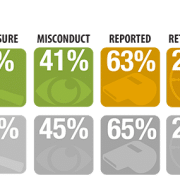The Lucifer Effect
The Lucifer Effect: Understanding How Good People Turn Evil
by Philip Zimbardo
Random House Publishing Group, 1st Ed. Reprint (2008) (public library)
Summarized by Joshua Elle
Overview
In a compelling story of his own life’s journey, Phil Zimbardo juxtaposes his famous Stanford Prison Experiment (SPE) and the equally famous Milgram experiment on obedience to authority with the scandalous events at the Abu Ghraib prison during the war in Iraq. The title, The Lucifer Effect, refers to the extreme transformative arc from good to evil that God’s favorite angel Lucifer underwent, and provides a context within which to examine lesser human transformations from good to evil. His main point is that while individuals should be held responsible for their own conduct, we must also examine the Situational and Systemic factors that shape individual conduct. We must accept that there aren’t just bad apples, but bad barrels, and in turn bad barrel makers. Zimbardo’s three tiered analysis categories are: Person, Situation, and System. The conclusion of the book proposes to continue to study the power of Situational and Systemic forces that can influence normal individuals to commit evil, inhumane acts, but also with the thought of turning that influence in the direction of heroic, humane behavior.
Application to Ethical Systems
It is rarely reasonable to attribute bad organizational outcomes solely to the few individuals who get caught. Zimbardo’s approach to examining the Situational and Systemic factors, rather than merely the Personal factors, should help readers to inoculate their organizations against unethical behavior. Specifically, precautionary measures should include avoiding the belief that individuals are invulnerable to Situational forces, being wary of the increased power of Situational forces in novel situations, and knowing that seemingly benign details present in the Situation and System can have deleterious effects, which can quickly become uncontrollable. The Lucifer Effect can also be seen as a stern reminder to take greater care in designing the systems we use to keep organizations functioning, and to take great care in the day to day leadership of organizations.
Chapter Summaries
Chapter 1: The Psychology of Evil: Situated Character Transformations
The journey begins with the question, “am I capable of evil?” Zimbardo then highlights three psychological truths: the world is filled with both good and evil; the barrier between the two is permeable; and angels and devils can switch.
In Zimbardo’s words, “evil consists in intentionally behaving in ways that harm, abuse, demean, dehumanize, or destroy innocent others — or using one’s authority and systemic power to encourage or permit others to do so on your behalf.”
The red thread of evil is traced through a number of nefarious systems of power that ended up committing atrocious crimes against humanity, from Homer’s account of the Trojan War where Agamemnon orders the slaughtering of Trojan women and children, to the Hutus slaughtering the Tutsis in Rwanda in the early 1990s, and to the Japanese slaughtering Chinese civilians during World War II. The abject dehumanization and moral disengagement that facilitated these atrocities is also observed in laboratories like Zimbardo’s SPE and in the Abu Ghraib prison.
Chapter 2: Sunday’s Surprise Arrests
This chapter begins by highlighting the characteristics of Palo Alto, California, from where the SPE participants are drawn. Zimbardo compares the characteristics of the community of Palo Alto with that of the Bronx, New York by describing a field study he conducted that compared the treatment an abandoned automobile in each neighborhood. The situational factors present in the Bronx created anonymity and deindividuation; the automobile was plundered shortly after being abandoned. The same automobile in the setting of a Palo Alto community where there was a lack of anonymity and individuation went untouched. Within that setting, the remainder of the chapter describes the details of how the initial arrests of the SPE participants were carried out.
Chapter 3: Let Sunday’s Degradation Rituals Begin
Once the prisoners and guards slip into their respective roles it is not long before degradation begins. The rules of the prison community were expressly intended to create a harmonious setting, but with the donning of the guards’ and prisoners’ titles and attire, the guards asserted their new authority with creative evil or inaction, whereas the prisoners became rather submissive.
Chapter 4: Monday’s Prisoner Rebellion
This chapter recounts how each individual gets further into his role. Some of the prisoners do begin rebelling, even become so distraught that they have to be removed from the experiment.
Chapter 5: Tuesday’s Double Trouble: Visitors and Rioters
Family members of the prisoners visiting the prison see the mental and physical toll that the SPE has taken upon their sons, boyfriends, or brothers. They leave convincing themselves that the mock-prisoners are tough and that they can endure, rather than thinking to question the sense in continuing to conduct such an experiment that would exact such a toll on their loved ones. In other words, dispositional factors are used to avoid confronting the Situational and Systemic flaws that have arisen. By now, Zimbardo himself felt that he was ever more enveloped in his role as a prison superintendent, and no longer an unbiased, objective researcher.
Chapter 6: Wednesday Is Spiraling Out of Control
A priest is called in to speak with the prisoners, and even he gets sucked into the role pressed upon him by the Stanford Prison. Two standby participants are inserted into the roles of prisoners, one as an agent provocateur working for Zimbardo who soon turns to aid his fellow prisoner, and a second who begins to wage a battle of wills against the prison guards and administration by starting a hunger strike.
Chapter 7: The Power of Parole
A parole board is convened that is made up of one man recently paroled from the California State prison system. Despite his having been turned down by many a parole board during his lengthy sentence, he fails to act compassionately toward these mock prisoners. He is overcome by the situation, and pulled down into his role on the other side of the table. When asked if the prisoners would be willing to forfeit their pay for the experiment in exchange for their freedom, they agree that they would, but still allow themselves to be handcuffed and escorted back to their cells.
Chapter 8: Thursday’s Reality Confrontations
By now the roles have come to rule not only the participants’ emotions, but their reasoning. Later in the evening Zimbardo is confronted by a recent doctoral graduate, who is also Zimbardo’s romantic interest. She exclaims that what he was doing to those boys was terrible. Her message faced stern resistance by Zimbardo, and it wasn’t until past midnight that he was won over, apologized to her, and resolved to terminate the experiment come morning. As this unfolded the guards were subjecting the prisoners to sexually humiliating treatment, prompting one of Zimbardo’s assistants to also conclude that the experiment should be terminated.
Chapter 9: Friday’s Fade to Black
Things come to an end and the debriefing takes place. In analyzing what had come to pass, Zimbardo explains that:
“the System includes the Situation, but it is more enduring, more widespread, involving extensive networks of people, their expectations, norms, policies, and, perhaps, laws. Over time, Systems come to have a historical foundation and sometimes also a political and economic power structure that governs and directs the behavior of many people within its sphere of influence. Systems are the engines that run situations that create behavioral contexts that influence the human action of those under their control. At some point, the System may become an autonomous entity, independent of those who initially started it or even those in apparent authority within its power structure. Each System comes to develop a culture of its own, as many Systems collectively come to contribute to the culture of a society.” (179-80).
It was astounding to Zimbardo the kind of moral re-education that took place, where the pattern of getting into the act occurred with almost every outside visitor. Even the worst-behaving guard was left wondering, “why didn’t people say something when I started to abuse people?” (194).
Chapter 10: The SPE’s Meaning and Messages: The Alchemy of Character Transformations
Zimbardo notes that the prisoners exhibited a passivity, dependency, and depression resembling Martin Seligman’s idea of Learned Helplessness. There were personal transformations resembling that of Dr. Jekyll and Mr. Hyde. What brought about this drastic change was a Situation, both sanctioned and maintained by a background System that Zimbardo helped create. Some key observations applicable to mock prisoners in the SPE–as well as to Nazi doctors during the Holocaust–are stated in this chapter as follows: “…by creating this myth of our invulnerability to situational forces, we set ourselves up for a fall by not being sufficiently vigilant to situational forces.” (211). “Situational power is most salient in novel settings, those in which people cannot call on previous guidelines for their new behavioral options.” (212). “The System’s procedures are considered reasonable and appropriate as the ideology comes to be accepted as sacred.” (226). Zimbardo stresses that the Situational and Systemic approach will prevent one from making the fundamental attribution error whereby all blame (and credit) is given to the individual. He also notes the human propensity for fallacious post hoc justification.
Chapter 11: The SPE: Ethics and Extensions
In this chapter Zimbardo discusses absolute and relative ethics, and how the obviously unethical outcome of the SPE was set up in a manner that received official sponsorship and approval. The experiment involved no deception, and was open to inspection by outsiders. The remainder of the chapter covers the follow-on stories of many of the people involved, as well as concepts that lead to further research.
Chapter 12: Investigating Social Dynamics: Power, Conformity, and Obedience
Zimbardo frames this chapter using C.S. Lewis’ idea that people often desire to be inside some inner ring. He explains that the dramatic changes for the worse occur through the manipulation of mundane aspects of human nature. He highlights other experiments, such as Milgram’s, that illustrate this phenomenon. Then he explores the historical applicability of the “Banality of Evil,” from Nazis, to suicide bombers, to school shooters, and to Jim Jones cultists.
Chapter 13: Investigating Social Dynamics: Deindividuation, Dehumanizaiton, and the Evil of Inaction
Explaining the plasticity of human nature, Zimbardo postulates that, “what we are is shaped both by the broad systems that govern our lives — wealth and poverty, geography and climate, historical epoch, cultural, political and religious dominance — and by the specific situations we deal with daily. Those forces in turn interact with our basic biology and personality.” (298). He discusses work by Albert Bandura on the effects of humanizing and dehumanizing labels (308). Zimbardo recommends that, “by making explicit the mental mechanisms people use to disengage their moral standards from their conduct, we are in a better position to reverse the process, reaffirming the need for moral engagement as crucial for promoting empathetic humaneness among people.” (311). He also goes on to explore the Evil of Inaction, to include bystander effects and conditions.
Chapter 14: Abu Ghraib’s Abuses and Tortures: Understanding and Personalizing Its Horrors
Zimbardo offers thorough examinations of the perpetrators convicted in connection with the atrocities that occurred at Abu Ghraib’s prison. He constructs a compelling argument for his System design considerations. About Chip Frederick, whose sentence was the longest, Zimbardo concludes that “he could have been the best of apples in [the US military’s] good barrels.” (344). This is not a plea from Zimbardo to wholly excuse the heinous acts of these individuals, but to suggest that the influential power of the System should be considered in mitigating their sentences, and should lead to looking up the chain of command for additional liable parties.
Chapter 15: Putting the System on Trial: Command Complicity
Here Zimbardo examines the systemic problems, the plausible deniability, the admitted failure of leadership, and even the acknowledgement that the SPE’s finding had not been heeded, which have all been missing from the service of justice in this matter. He introduces, “a new kind of modern evil, ‘administrative evil,’ that constitutes the foundation of complicity of the chain of political and military command in these abuse tortures. Both public and private organizations, because they operate within a legal framework, not an ethical framework, can inflict suffering, even death, on people by following cold rationality for achieving the goals of their ideology, a master plan, a cost-benefit equation, or the bottom line of profit.” (381).
Chapter 16: Resisting Situational Influences and Celebrating Heroism
Zimbardo envisions creating a “Reverse Milgram” experiment where people comply with intensifying demands to do good. Zimbardo further discusses what it means to be heroic: “For an act of personal defiance to be worthy of being considered ‘heroic,’ it must attempt to change the system, to correct an injustice, to right a wrong.” (458); “Disobedience by the individual must get translated into systemic disobedience that forces change in the situation or agency itself and not just in some operating conditions.” (459); “It is all to easy for evil situations to co-opt the intentions of good dissidents or even heroic rebels by giving them medals for their deeds and a gift certificate for keeping their opinions to themselves.” (459); “Heroism can be defined as having four key features: (a) it must be engaged in voluntarily; (b) it must involve a risk or potential sacrifice, such as the threat of death, an immediate threat to physical integrity, a long-term threat to health, or the potential for serious degradation of one’s quality of life; (c) it must be conducted in service to one or more other people or the community as a whole; and (d) it must be without secondary extrinsic gain anticipated at the time of the act.” (466). Zimbardo further explores the “Banality of Heroism” (485), explicating situational action vectors, which he states are: “group pressures and group identity, the diffusion of responsibility for the action, a temporal focus on the immediate moment without concern for consequences stemming from the act in the future, presence of social models, and commitment to an ideology.”
To Learn More:
-
See Zimbardo’s TED talk: The Psychology of Evil
-
Visit Zimbardo’s Heroic Imagination Project




